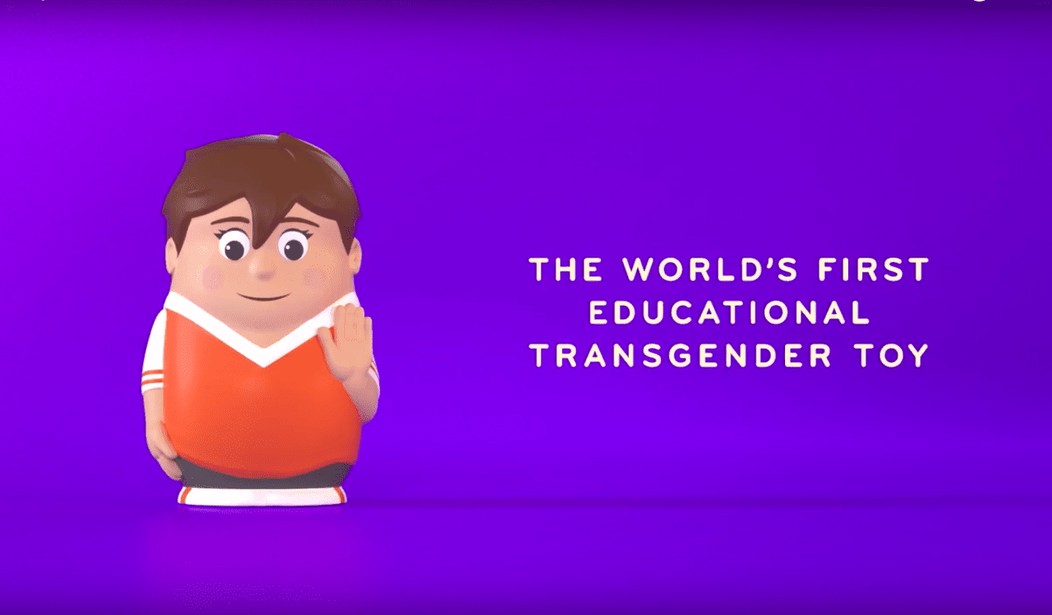Transgender activists are promoting a gender-transition Russian doll, which teaches children at a very early age the idea of rejecting their birth sex for an opposite sex identity. While this would not be the first transgender doll, it would be the first doll with an explicit gender-transition message.
“Our mission is to educate people around the world about gender identity issues. Sam is an essential tool designed to help children understand what it means to grow up as a transgender child,” the fundraising campaign on Kickstarter explains.
As of Sunday, the campaign had raised $14,588 of the $108,725 goal. The campaign is “all or nothing,” which means that if it reaches the goal by the deadline of August 12, 2017, it will be launched. If not, it will not see the light of day.
The project was conceived by the Canadian nonprofit Gender Creative Kids, a Montreal-based group started in 2013. The nonprofit worked with researchers, transgender children and their families, and the design firm LG2.
“We believe that this toy can … open the conversation, whatever gender identity the child feels, and also promote acceptance of the fact that some people feel different from their assigned sex at birth,” Annie Pullen Sansfaçon, vice president of the Canadian nonprofit, told The Daily Beast.
Sansfaçon added, “We identified the lack of a practical tool to initiate conversation about gender identity with trans children—and with other children that may know a gender creative kid, or who are questioning their own gender.”
The doll, named Sam, consists of six phases in gender transition, all of which are outlined in a video also pushed by Gender Creative Kids.
Sam begins as a “happy” girl baby. The Kickstarter campaign explained, “Sam starts life happily unaware of what gender even is.” In the next phase, Sam is “exploring,” playing builder and drawing a mustache on her face despite her feminine long hair. Sam then “starts questioning cultural gender norms and how he fits — or doesn’t fit — within them.”
After questioning, the girl becomes conflicted, “constantly torn between internal feelings and external expectations.” She cuts her hair, in a symbol of rejecting her femininity. Not “feeling accepted,” she later isolates herself, with an unhappy doll in a black hoodie, putting her hands in her pockets.
The final stage involves a happy Sam, who “finally feels accepted and supported in the expression of his true identity.”
These successive stages tell a narrative — from sad girl to happy “boy.”
But “Gender Creative Kids” has also launched a YouTube video to fit the Russian doll toy. The video does not just present transgender ideology — it uses the analogy of twins to promote a fully Gnostic view of humanity. Cutesy and upbeat, it suggests that gender identity issues are perfectly normal and should be accepted, rather than challenged.
In the video, Sam interacts with her “twin brother,” but at the end of the video it becomes clear that Sam is an only child — the brother represented her “masculine side,” and when she finally becomes at peace about gender, she merges with this “twin” to become one united person.
In his book God and the Transgender Debate, Andrew Walker, director of policy studies at the Southern Baptist Convention’s Ethics and Religious Liberty Commission (ERLC), explained the ideological underpinnings of transgenderism.
Gnosticism, an ancient religious philosophy which predated Christianity and penetrated the early church, taught that “matter” is bad and broken, that a person will not be happy until he or she escapes from the world. The philosophy taught a tension between one’s true self and the bodies people inhabit.
“The concept that our gender can be different than our biological sex is a modern form of the old Gnostic idea,” Walker explained in his book. “What this means, practically, is that a man can identify as a woman, even if they have male chromosomes and the body of a man.”
While transgenderism does not reject matter as evil, its Gnostic influences are very clear from the “Sam” video. At the center of the Russian doll is a heart, which represents “Sam’s true self,” something not to be confused with the female body Sam inhabits.
The idea of Sam “projecting” her twin brother — and then joining with him — suggests that Sam’s true identity is not physical. It also suggests that the body is not really real, and can be jettisoned in favor of a more “genuinely” felt identity.
Children who watch this video, play with this doll, and embrace transgenderism may have no idea that their basic approach to the world and humanity is being influenced by an ancient religious philosophy. They may have no real disposition to identify with the opposite gender, but become confused by the push for transgenderism.
Psychiatrists have warned that transgender identity has become a fad among young people today. “One said to me, Dr. Steve … I want to be transgender, it’s the new black,'” recalled Dr. Stephen Stathis, an Australian pediatric psychiatrist. He said many adolescents have started “trying out being transgender.”
Stathis added that most of these children do not really suffer from gender dysphoria, the strong persistent feeling of identification with the gender opposite one’s birth sex. He predicted that by the time these kids reach puberty, most will identify as their birth gender.
If young boys and girls start playing with the Sam doll, and watching the associated video, more and more of those who do not suffer from gender dysphoria might struggle with complex gender issues. They may also be unconsciously influenced by arguably dangerous ideas.
One of the dangers in all this is that LGBT ideology can spoil childhood. Many parents believe that children should grow up without the added strain of dealing with gender identity and sexual issues.
At a time when parents are teaching their 8-year-old children about masturbation in videos on YouTube, when National Geographic puts a nine-year-old transgender girl on the cover, when drag queens perform at talent shows with 5-year-old kids in attendance, it seems harder and harder for parents to shield preteens from gender and sexuality issues.
If this doll gets off the ground, that will be just one more invasion of childhood innocence.










Join the conversation as a VIP Member